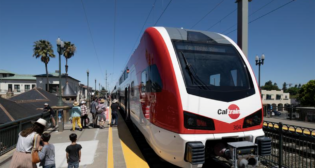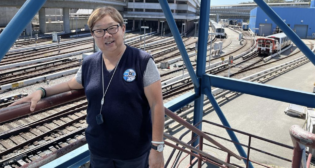
Quebec: Pension fund turns passenger rail operator
Written by David Thomas, Canadian Contributing EditorProposing a radical new business model, Quebec’s huge public pension fund announced April 22, 2016 that it will directly undertake construction and continuing operation of a 67-km (41.5-mile), double-tracked, electrified and fully automated rapid rail network, the Réseau électrique métropolitain (REM), which will transform commuting in Montreal and its immediate hinterland.
The REM, which will be an automated rapid transit system (though the city is calling it “light rail”), will serve 24 stations 20 hours a day, with departures every three to 12 minutes depending on route and time of day.
The Caisse de dépôt et placement du Québec pension fund will put up C$3 billion of the C$5.5 billion project, with the balance coming from the Quebec and Canadian governments as subordinate equity investors.
Because of its fiduciary responsibilities to protect old-age pension payouts, the deal will guarantee the Caisse first call on profits, with the two levels of government claiming their share only above an agreed-upon threshold. But the Caisse will not ask government to backstop its investment and will assume the business risks of ridership and revenue.
Thus, the pension fund, which last November acquired 30% of Bombardier’s global rail business, becomes a railway operator. Caisse CEO Michael Sabia was in the 1990s chief financial officer of Canadian National.
Quebec is the only Canadian province to run its own old-age security pension; the others are covered by Canada’s national pension system.
The REM will involve reconstruction and conversion of the existing AMT Deux-Montagnes line, which tunnels under Mount Royal to the city’s Central Station, as well as new right-of-way utilizing the existing Highway 40 route from the island city’s western tip to a connection with the Deux-Montagnes.
In addition, the REM will include a spur to Pierre Elliott Trudeau International Airport and will extend new trackage from downtown to the bedroom communities of the St. Lawrence River south shore via a new Champlain Bridge scheduled to open in 2018.
Overhead catenary will provide the power, with third-rail rejected because of Quebec’s icy winters. REM will be the third-longest driverless rail system in the world, after Dubai and Vancouver, and will employ 1,000 workers.
The initial fleet will consist of 200 150-passenger cars with open “boa” vestibules between them. Rush hour trains will consist of four cars, with two-car trains operating in off-peak hours.
The Caisse promises WiFi connectivity for all trains and live smartphone access to actual train times. Fares will be comparable to existing tariffs for travel on the existing commuter train and bus services.
Sabia says construction should start in Spring 2017 with the full system operational in 2020. Procurement and environment assessment hearings are to begin this summer.
Montreal Mayor Denis Coderre endorsed the project, assuring that rights-of-way and infrastructure currently belonging to the city’s’ transit system (not including the Montreal Metro, operated by STM, Société de transport de Montréal) will transition to the new REM. The project fits with Montreal’s declared ambition to convert its bus fleet to electricity and provide a network of vehicle charging stations for public use.
The ambitious timeline depends on agreement by the federal and provincial governments to join in the Caisse’s scheme for a “public-public” partnership in which future seniors are the primary equity holders. Sabia said the business model is “a virtuous circle in which profits from passenger fares will feed public pension payouts. Every time passengers use their new transit system, they will be helping to secure their future retirement.”




